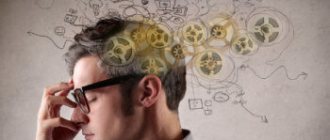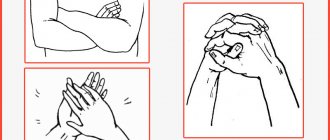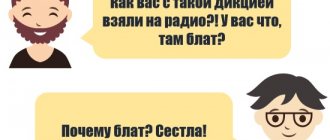What to do if the child is inattentive? How can I help him study better? How can an adult develop memory and imagination?
The human brain is designed in such a way that each hemisphere has its own specialization. In particular, the left hemisphere is responsible for logical and analytical thinking, abilities in languages and mathematics, perception of oral and written speech, memorization of facts, control of the right half of the body. The right hemisphere processes non-verbal information, is responsible for spatial orientation, musical abilities, imagination, creativity, parallel processing of information and control of the left half of the body. Human intelligence is based primarily on the coordinated work of both hemispheres.
Are you preparing your child for school correctly?
If parents take the phrase “after three it’s too late” too literally and enroll a child under 5.5 years old in all the “developmental activities” in a row:
- music,
- English,
- reading,
- account, etc.,
then, as a result, the left hemisphere develops too quickly, to the detriment of the right, and the neural connections between them are weak and few in number. What happens to such a child at school? Although, at first glance, he is more than ready to learn, he has difficulty concentrating on the lesson, writes with errors, and does not perceive the educational material well.
The development of human intelligence directly depends on how closely the left and right hemispheres of the brain are connected. The largest number of nerve connections between them is formed when cross movements are performed regularly, that is, on the left and right sides of the body. It is not for nothing that neuropsychologists recommend starting preparation for school not with the alphabet and copybooks, but with teaching:
- landing when writing;
- gripping a pen or pencil;
- orientation in space;
- as well as the development of large and fine motor skills.
Psychological and pedagogical research confirms: the more a child moves and the better he coordinates his movements, the more his higher mental functions are developed.
Exercise for the mind
Many parents see the reason for their children's school failure in high academic loads. “A child is asked so much, he simply doesn’t have time to remember everything!” “Failed again in dictation! But we prepared at home, learned all the rules. Where does such inattention come from?!” Of course, in some cases the problem is laziness and a child’s lack of interest in learning. However, experts who study brain processes say that there is no such thing as poor memory and inattention. It's all about the inability to train them. Today there are special sets of gymnastic exercises for training and effective development of cognitive functions. What kind of exercises are these? How to master them? Let's talk about this.
Scientists have proven that our brain is very flexible and plastic, and our memory is truly limitless. Throughout life, some connections in the brain constantly die off and other, new, connections are formed again.
It is the brain that ensures the optimal functioning of processes such as memory, attention, perception, thinking, speech. Moreover, all these processes tend to develop dynamically in favorable conditions and deteriorate in damaging situations. The latter include neuropsychological stress at school.
Indeed, the intensity of the modern educational process requires the student to fully devote himself in terms of cognitive, or educational, activity (from the Latin cognitio - “cognition”).
“And if we also take into account the high level of morbidity among today’s schoolchildren, it becomes clear that the student cannot always cope with the workload offered to him,” notes neurologist Elena Vasilievna Kovaleva.
Problems with academic performance associated with poor readiness of the cognitive sphere manifest themselves in the process of study in the form of poor memory, impaired memorization, decreased attention, increased fatigue and decreased motivation for cognitive activity. Such children miss letters in dictations, do not count well orally, and cannot maintain attention throughout the entire lesson.
How can you help your child become more attentive, learn to focus on important things and make the most of his memory resources? It turns out there is a very effective way to do this. As a specialist, Elena Kovaleva sees a solution to the problem in special brain training:
By incorporating cognitive gymnastics into the learning process, we can activate the mind-body system and improve the child’s ability to learn.
Performing special exercises leads to the restoration of interhemispheric connections, improvement of the psycho-emotional state, and stimulates the development of cognitive functions. Properly organized movements help create new neural networks and, accordingly, expand the reserve capabilities of the brain. At the same time, the exercises are quite simple and understandable, so they do not tire the child and do not burden the learning process.
Cognitive gymnastics exercises are based on the Brain Gymnastics program, developed in the 70s by the American scientist Paul I. Dennison for underachieving children.
The remarkable thing is that this set of exercises allows you to improve the child’s condition and performance at school without any medication load on the growing body. Note that classes provide both immediate and cumulative effects. And the greatest results can be achieved if you perform the complex accurately and systematically.
Comparative diagnostics before and after performing the complex confirms that children have improved memory, attention, speech, increased performance and reduced fatigue.
Dennison hooks
The exercise should be performed before a lesson, test, exam, public speaking, when you need to calm down and make the right decision, as well as in a state of excitement or depression. The exercise harmonizes emotions and thinking processes, eases mental stress, promotes adequate actions and behavior, helps to perceive new things. information, to better understand the point of view of another and your own, consists of two parts.
Part 1.
Stand with your legs crossed. In this case, the feet rest firmly on the floor. Extend your arms in front of you parallel to the floor. Cross them so that your palms meet each other and interlock your fingers. Bend your elbows, turn your hands inward and press them to your chest so that your elbows are pointing down. Press your tongue against the hard palate just behind your upper teeth. Raise your eyes upward and keep your gaze in that direction. The chin is lowered, the head is not raised. Breathing is calm, body is relaxed. You may sway slightly - this is a normal reaction of the body. If the shaking is strong, it is better to sit in the same position.
Part 2.
Place your feet parallel. Open the hand lock, lower your arms and connect the fingertips of both hands with each other. Place them so that the joined thumbs are parallel to the floor and the rest are pointing down. The exercise takes two minutes or more. Now you need to look at the floor, but don’t lower your head. The tongue still rests on the hard palate. Stay there, relaxed, a little longer.
Cognitive gymnastics
It is a set of special exercises, during which a connection is established between the kinesthetic, visual, optomotor and auditory systems. In addition to cognitive gymnastics, the Center uses:
- transcranial magnetic stimulation of the brain can significantly improve the conduction of nerve impulses along the cortical pathways.
- electropulse therapy - electrosleep. The therapeutic effects of electrosleep include anti-stress, sedative and stimulating effects that increase overall vitality.
Massage of back and head muscles
Massage techniques stimulate and increase the tone of the central nervous system, have a relaxing effect, which has a positive effect on the activity of all physiological systems of the body.
Homeopathy
Homeopathic medicines are selected for each specific case according to the law of similarity, taking into account the patient’s condition, his constitutional and psychological type, hobbies, mood, eating habits, favorite sleeping position, dependence of complaints on the time of day, cold or heat, dampness, food intake and many other individual characteristics.
Exercises for the formation of interhemispheric connections
What to do if time is lost, the child is already in school and his progress leaves much to be desired? Pediatric neuropsychologists advise regularly performing sets of kinesiological (motor) exercises aimed at enhancing the formation and strengthening of neural connections between the hemispheres. They are helping:
- improve thinking and memory;
- make the hemispheres work more harmoniously;
- concentrate attention;
- facilitate the process of reading and writing.
Here are some exercises that both kids and adults are sure to enjoy.
Drawing with two hands
It is better to start the exercise by tracing the contours of simple symmetrical drawings. It is desirable that the image is divided by an axis of symmetry. You can draw with both paints and felt-tip pens, soft pencils. Place the sheet on a table or easel. Take a pencil in each hand and place them at the top point, then begin to move them down along the outline of the drawing. Make sure that the dominant hand does not overtake the subordinate hand. The essence of the exercise is the simultaneity of all actions. Kids can draw with their fingers and palms.
Modeling and origami
Both hands and eyes are involved in folding paper figures and giving salt dough or plasticine a certain shape. This exercise has a positive effect on hand-eye coordination, logical thinking and imagination.
Play with colors
Write down on a piece of paper the names of different colors of the palette with pens with colored paste, felt-tip pens or pencils that do not correspond to them in color, for example, for the word “red” use a blue pencil, and for the word “black” use a yellow pencil. Now, with support on the sheet, say only the names of the colors with which the words are written. Try to do this as quickly as possible. At first the chains should be short: three or four words, then the number of names can be increased.
"Dance"
With your left hand clenched into a fist, with your thumb turned to the side, touch your right little finger. Switch hands. Try to make movements quickly and accurately.
Try on someone else's skin
Sometimes perform habitual actions not with your dominant hand, but with your subordinate hand. For example, if you are right-handed, try stirring tea with your left hand, turning the keys in the lock, or typing a text message.
How to make your brain work better? Prevention of cognitive impairment
Publication date: 08/19/2021 Articles
The brain can work intensely and productively, but it is lazy. He tries as much as possible to simplify any task for himself, act according to a proven algorithm and avoid any actions. But to avoid memory degradation, decreased mental performance and other cognitive impairments, the brain must be regularly forced to work and train. How exactly to do this, the chief physician of the Stavropol Regional Psychiatric Hospital No. 1, Oleg Boev, the Svoe TV channel.
Don't be distracted by gadgets!
This is paradoxical: gadgets are designed to simplify life and make it more comfortable, but their regular use reduces the productivity of the brain. Being in a constant flow of information, the habit of monitoring news and social networks several times an hour can negatively affect thinking, consciousness, memory - they do not develop, and even degrade. It takes up to 20 seconds for the brain to fully activate the thought process. This process is interrupted when you are distracted by browsing social networks, quickly reading the news, or responding to a message in the messenger. Even after a pause of a few seconds, the brain has to start the thought process from the very beginning.
For children, constantly “sitting” on gadgets has more serious consequences - their memory and thinking do not have time to fully form. According to the chief psychiatrist of the North Caucasian Federal District, such children grow up, but cannot fully comprehend what is happening, analyze, correctly formulate their thoughts, calculate their actions several steps ahead and try to predict the future. This means that modern technologies are destroying the capabilities of the brain formed over millions of years.
The pandemic has demonstrated society's high dependence on information consumption. It is no coincidence that about a year ago the term “infodemic” appeared - the defeat of society by an “information virus”, the appearance in the information space of a large number of fake materials, causing panic and changing mass consciousness. The pandemic situation has shown that there are many people who cannot go to bed or do anything until they read social networks and watch the news. A large percentage of this information has no value and only overloads the brain. But if a person does not watch social networks and news feeds, does not receive messages and reactions to his publications, his anxiety may increase, panic, apathy, despondency, a feeling of uselessness may appear, and interest in life will decrease. Goals are blurred, the future seems bleak and unpromising. A person becomes dependent, which prevents healthy longevity and high mental performance.
How to improve brain function?
Spend less time on gadgets and filter information that comes from outside. The pandemic has shown that “information” hygiene is important to maintain mental health: the ability to analyze news without emotions and trust only official sources.
For the brain to work productively, it needs to be forced into action and new non-standard tasks set before it. The brain needs to be trained just like the body. To preserve and develop cognitive functions, you need to read, retell what you read, practice calligraphy, and learn languages. By the way, it is learning languages and playing musical instruments that prevents dementia. And during calligraphic writing, several brain centers are activated at once.
The efficiency of the brain directly depends on physical activity. It should be constant and fun. It doesn't have to be grueling workouts. There will be an effect even if you do simple gymnastics, walk, get up from your desk during the working day and perform a few simple exercises. Blood will better nourish the brain, which means its productivity will increase.
Full version of the interview
Read our articles
Watch and read us on social networks
The illustration for this publication was taken from the public image library https://www.freepik.com/ and from open sources. You can read in detail about using illustrations from the Freepik library here
What might you need to train at home?
For home workouts you don’t need almost anything except desire, time and a little space, but it is important to understand which exercises to choose for self-training so as not to harm your health and achieve the desired results. As for additional attributes, you shouldn’t rush to a sports store to buy an exercise bike or treadmill; prepare a minimum set
:
- gymnastic mat;
- dumbbells;
- fitness bands.
What is the best time to train?
People who have developed the healthy habit of doing exercises in the morning cannot imagine starting their day without squats, push-ups, bending over or stretching. True, among them there are usually more “larks”, because “night owls” can force themselves to get up a few minutes earlier only by force of will, but evening workouts are much more pleasant for them. Thus, if you are not going to break your routine and your nature, then exercise when it is convenient for you
.
There is also a compromise option: do a small set of dynamic exercises in the morning to help you cheer up, and in the evening take time for stretching, yoga and other exercises that will help relieve the stress of the day and prepare for a relaxing evening.










